 |
[August 9th , 2005]
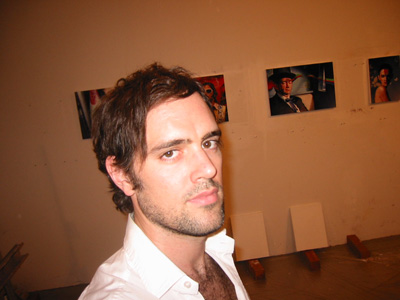 Jeremy Blake Jeremy Blake
The Winchester Trilogy - Interview with Jeremy Blake
During the last five years Jeremy Blake has established himself on the international art scene with his fusion of abstract paintings, film footage, sound and animation. A process he himself describes as ‘time-based paintings'. His continually looping DVDs have been projected on plasma screens at museums world wide, and outside the traditional art institutions his hallucinatory transmutations of colors and shapes have played an important part in Paul Thomas Anderson's movie Punch-Drunk Love and served as a visual accompaniment to Beck's live shows during his Sea Change tour.
Until October 1oth his Winchester trilogy, Winchester (2002), 1906 (2003), and Century 21 (2004) is shown at the San Francisco Museum of Modern Art, where Torben Olander recently met the artist.
Accompanied by individual soundtracks, the 21-minute loop of the Winchester trilogy slowly unfolds on three large screens in front of the audience. A slightly blurred image of the Winchester Mystery House appears furthest to the left. The Winchester Rifle heiress, Sarah Winchester, built the 160-room Victorian mansion in San Jose. From 1884 and 38 years onwards she kept 22 carpenters at work 24 hours a day, following the instructions given to her by a spiritualist medium she had visited after the death of her daughter and husband. The medium explained that spirits of the thousands of persons, who had died because of the Winchester riffle, were now seeking vengeance and would ultimately kill her too. To save herself she had to build, and continue to build, a house for herself and the spirits. If she stopped she would die. Thus Sarah spent her inherited fortune adding room upon room, creating an architectural marvel with staircases leading nowhere, trap doors, chimneys serving no purpose and double-back hallways until she died in her sleep in 1922.
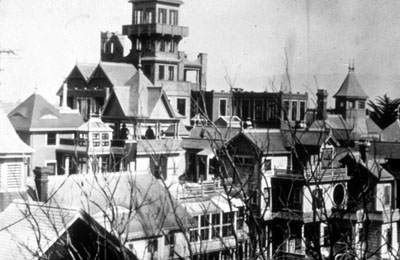
The Exterior Tower of the Winchester Mystery House in San Jose
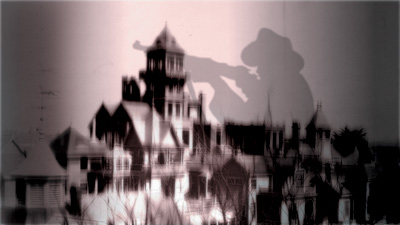 Jeremy Blake, Winchester (still), from Winchester trilogy, 2002; DVD with sound; 18-minute continuous loop; courtesy of the artist and Feigen Contemporary, New York; © Jeremy Blake Jeremy Blake, Winchester (still), from Winchester trilogy, 2002; DVD with sound; 18-minute continuous loop; courtesy of the artist and Feigen Contemporary, New York; © Jeremy Blake
What attracted you to the Winchester house?
The combination of it being symbolical powerful and not particular researched in a serious way. At least I didn't know of any artworks based on the Winchester House, so to me it was some kind of buried treasure. It reminded me of the American obsession with massive scale and the sort of upper class monster houses that are being built in contemporary suburban America. I liked that the first one was build to house ghosts, because it captures something truly American about how we are working hard in this world, to get to the next. And then there is also the obsession with protection from unseen threats, which has become present again.
What is it that your work can tell us about the Winchester Houser, that a regular documentary cannot?
A documentary would be fascinating, but I'm not interested in being an historian. As an artist in a site like that, I would rather try to draw some sort of meaning. The way I did that was to show what I thought was the psychology of the builder of this house. In other words, what interests me was the neurosis of this person and the poetic powers of what they build, rather than the history in a more straightforward way. Sort of like the alchemist expression of the prose, where you're trying to show the motivation and psychic of the character by interpreting the surroundings.
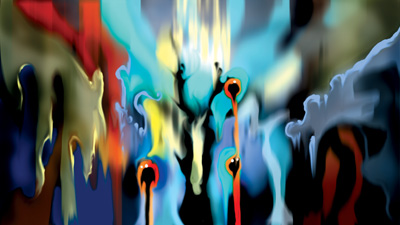
Jeremy Blake, Winchester (still), from Winchester trilogy, 2002; DVD with sound; 18-minute continuous loop; courtesy of the artist and Feigen Contemporary, New York; © Jeremy Blake
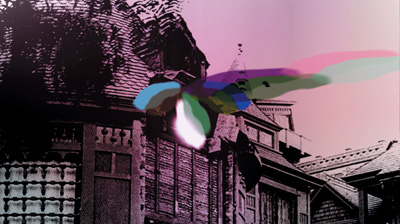
Jeremy Blake, 1906 (still), from Winchester trilogy, 2003; DVD with sound; 21-minute continuous loop; Collection SFMOMA, Accessions Committee Fund purchase; courtesy of the artist and Feigen Contemporary, New York; © Jeremy Blake
When did you first come up with the idea of adding animation or the element of time to your paintings?
I was messing around with both video and painting, when I was in art school back in 1993-1994. And it wasn't because I didn't like what I was doing, but I never felt that the two things met up until the computer reached a certain state that made it possible for me to combine the two. At the same time, I watched some films like 2001 and some of the independent film that inspired that. And I saw Truffaut's Fahrenheit 451 where the evil regime, that bans books, design these things that look like a flat screen to put inside peoples home. So as the technology emerged I thought it would be fun to do a show this way, and it turned out to be a very rich way to work.
It started out as being some kind of sarcastic remark, but then it ended up being serious, which is how it works for me. I usually think that I'm kidding until I find myself in the process and realize that I'm not.
What was your inspiration apart from the movies you've mentioned?
There are a lot of great abstract painters that I've looked at allot like
James Rosenquist,
Morris Louis and
Richard Prince.
Can you describe how your method and work has developed over the years?
It's like a musician that grows up playing piano and then at a certain age starts playing electric guitar. I started with painting and then found out it could be electric, it could be louder. I think every generation needs to find their own way, so as the computer allowed me to mix a lot of things that you could not mix before, I have gradually developed a more detailed narrative in my work. And lately I think I have progressed towards a more personal and dreaming kind of storytelling and away from the blips and blobs of formalism. It might have to do with the fact that I've gained an audience, so I feel people can follow me more and that I can talk more directly to them. I guess more of my personality comes through now.
How do you work?
It's like a small film project with me, a motion graphic guy, a sound editor and a musician or two. Generally I do all the live footage and then I give it to a motion graphic guy I work with. It is a very time consuming process and since there are people that are so much better at the technical stuff than I am, I prefer to work with a group. But I still oversee everything very carefully.
So you're more like the director of the piece?
Yeah, but not like a Hollywood director. There are a lot of people that are good at making Hollywood film, and at some point I might do that, but for now this is what I'm interested in. I see myself more as a combination of a director and a painter. I still paint every frame and scan it in.
Do you create a storyboard before hand?
Yeah. I usually start out with a huge pile off stuff that I like, and with a range of the subject matter, and then I try to see how much I can fit into that range. But I don't take notes that are incredible literal. I want to have room when I work and be able to do the strange left turn if I feel like it. It is often very rewarding when there is a lot of room for experimenting.
What are you working on at the moment?
A piece called Sodium Fox with David Berman from the rock band, Silver Jews. He is a poet as well, so I use some of his poetry to create a kind of loop narrative. I think it's the best that I've done so far. It opens at Feigen Contemporary in New York City on October 7 th , 2005.
Torben Olander studies at the Danish School of Journalism and is currently enrolled in an exchange program at San Francisco State University.
Links ...
Winchester Mystery House
An article on the Winchester House
San Francisco Museum of Modern Art
Jeremy Blake at Feigen Contemporary
|
 |
|